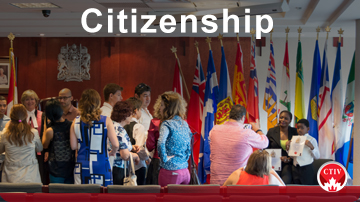To work in Canada on a temporary basis, foreign workers need the work permit. Immigration, Refugees and Citizenship Canada (IRCC) approve Canada work visas under the Temporary Foreign Worker Program (TFWP).
The journey to achieving Canadian citizenship is a significant milestone for many individuals who have previously obtained Permanent Residency (PR) in Canada. This guide aims to break down the step-by-step process of applying for Canadian citizenship, simplifying the legal jargon into more understandable terms while highlighting potential legal implications that applicants should be aware of.
The very first step in the citizenship application process is creating an online account with the Immigration, Refugees and Citizenship Canada (IRCC) website. This account is crucial as it allows applicants to manage their application and receive notifications. Once the account is created, applicants have 60 days to complete and submit their citizenship application.
Legal Implication: It is vital to ensure that the information provided during the account creation is accurate. Any discrepancies can potentially delay the application or raise questions regarding the applicant’s credibility.
After creating the account, the next step is to gather all necessary documentation and submit the application profile. This includes providing proof of PR status, identification documents, and language proficiency evidence. Applicants must also pay the required application fee, which varies based on age and the type of application.
Legal Concern: Incomplete documentation or incorrect fee payment can lead to application rejection. It’s essential to double-check all submissions to avoid delays or potential denial of citizenship.
Once the application is submitted, the next phase is the waiting period. Applicants will receive an Acknowledgment of Receipt (AOR), which serves as confirmation that the application has been received and is being processed.
Legal Note: The AOR is an important document. It is advisable to keep this for future reference, as it contains a tracking number that can be used to follow up on the application status.
With the AOR in hand, applicants can create a tracking application account. This online portal allows individuals to monitor their application status and receive updates directly from IRCC.
Legal Implication: Regularly checking the application status can help applicants stay informed about any additional requirements or changes in their application status.
After creating the tracking account, applicants will once again enter a waiting period. During this time, IRCC will begin updating the application profile. It is common for this process to take several months.
Legal Note: Patience is key during this stage. Applicants should ensure they are prepared for a potentially lengthy wait, as IRCC’s processing times can vary widely based on application volume and other factors.
Eventually, applicants will receive an invitation to take the citizenship test. This notification usually arrives after approximately three months, although it can take longer. The test assesses knowledge of Canadian history, culture, rights, and responsibilities.
Legal Concern: Applicants should be ready to study for the test, as failure to pass could result in delays or the need to retake the test, prolonging the citizenship process.
Upon receiving the invitation, applicants have 30 days to schedule and take the citizenship test. They can choose the date that works best for them within this timeframe.
Legal Note: It is important to adhere to the timeline provided. Failing to take the test within the allocated period may lead to the application being deemed abandoned.
After taking the test, applicants typically receive their results within 10 days. The IRCC will then update the application portal with the test results.
Legal Implication: Applicants should keep an eye on the portal for updates. If there are issues with the results, it is crucial to address them promptly with IRCC.
Once the test is passed, applicants will receive an invitation to take the citizenship oath. This is a ceremonial step that finalizes the citizenship process.
Legal Note: The oath-taking is a significant legal and symbolic act, solidifying the applicant’s commitment to Canada and its values.
The final step is the oath ceremony. On this day, applicants officially become Canadian citizens and will receive their citizenship certificate. At this point, they are required to return their PR card, as it is no longer valid once citizenship is granted.
Legal Concern: It is essential to ensure that all previous obligations as a PR are met before taking the oath, as any outstanding issues could potentially affect the citizenship approval.
Once citizenship is granted, new citizens can apply for a Canadian passport. This is an important document that allows for international travel and identifies the individual as a citizen of Canada.
Legal Note: It is advisable to apply for the passport as soon as possible following the citizenship ceremony to avoid complications or delays in travel plans.
The path to Canadian citizenship is detailed and requires careful attention to timelines, documentation, and procedural requirements. Each step is interconnected, and any misstep could result in delays or complications. By understanding the process and its legal implications, applicants can navigate their journey to citizenship more effectively.
Potential legal issues may arise if applicants fail to meet deadlines, provide incomplete information, or overlook the importance of maintaining their PR status throughout the process. Therefore, it is crucial for individuals to remain diligent, organized, and informed as they pursue their goal of becoming a Canadian citizen.
Q1: Who is Sanjay Prasher and how can he help with my Canadian citizenship application?
A: Sanjay Prasher is a Regulated Canadian Immigration Consultant (RCIC) based in North York, Toronto. With over 9 years of experience, he specializes in guiding clients through the Canadian citizenship application process, including online applications, citizenship tests, and navigating IRCC requirements24.
Q2: What are the main requirements for Canadian citizenship in 2025?
A: Key requirements include:
Valid permanent resident status
Physical presence in Canada for 1,095 days within the last 5 years
Filing taxes for at least 3 years
Passing the citizenship test (ages 18-54)
Proving English or French proficiency (ages 18-54)7
Q3: Can I apply for Canadian citizenship online?
A: Yes, most applicants can now apply online through the IRCC portal. However, some situations may require paper applications, such as crown servants or those using representatives37.
Q4: What forms do I need for my citizenship application?
A: The main form is the citizenship application form, which varies based on your status (adult, minor, etc.). Additional forms may include document checklists and language proficiency proof13.
Q5: How long does the Canadian citizenship application process take?
A: Processing times vary, but typically range from 12 to 18 months. Sanjay Prasher can provide more accurate timelines based on current IRCC processing speeds5.
Q6: How can I prepare for the Canadian citizenship test?
A: Study the official citizenship guide, use online resources, and consider enrolling in test preparation programs. Sanjay Prasher offers guidance tailored to the latest test format57.
Q7: What happens after I submit my citizenship application?
A: IRCC will send a confirmation of receipt. You can then track your application status online and prepare for the citizenship test and interview5.
Q8: How do I transition from permanent resident to citizen?
A: Follow the application steps, meet residency requirements, pass the citizenship test, and attend the citizenship ceremony to take the Oath of Citizenship7.
Q9: Can Sanjay Prasher help with expedited citizenship applications?
A: While most applications follow standard processing, Sanjay can advise on situations that may qualify for urgent processing and guide you through the procedure3.
Q10: Where is Sanjay Prasher's office located in Toronto?
A: Sanjay Prasher's office, Canadian Title Immigration and Visa Consulting (CTIV), is located in North York, Toronto. Contact him at +1 416-542-1000 for consultations

To work in Canada on a temporary basis, foreign workers need the work permit. Immigration, Refugees and Citizenship Canada (IRCC) approve Canada work visas under the Temporary Foreign Worker Program (TFWP).

Obtaining and applying for Canadian citizenship can be a long and labour-intensive process as law changes very fast. We keep you posted on citizenship application requirements. We are your Citizenship application process immigration consultant.